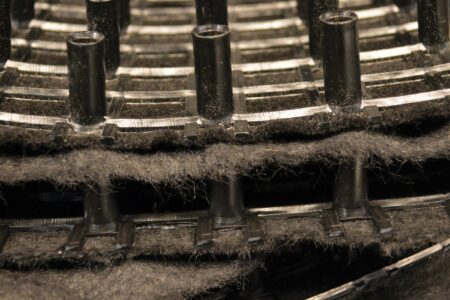Install Downspout Extensions to Avoid a Wet Basement
A 2,000 square foot roof will put out nearly 1,250 gallons of water for every inch of rain. That’s a lot of water.
With that much coming down, your rain gutter must be ready to handle it. If not, a lousy drainage system puts your home at risk for severe water damage.
Ensuring your drainage system is up to par involves two critical things. First of all, you should always consider if your gutter system is clear. If there is a clog in any one part of the gutters, it can redirect water toward an undesirable location (like right next to your home).
However, simply clearing out your downspouts and gutters now and then isn’t always enough. Even if they are clear, you also need to direct the stream of rainwater far away from your foundation.
If you don’t funnel water away from your house, you risk getting basement leaks and foundation cracks.
Gutters and downspouts move the rainwater away from the home’s foundation. While they intend to keep the home safe from water build-up, many gutter systems fall short – literally.
One of the most common issues we see in gutter inspections is that the downspout is draining the water too close to the home. This issue causes the soil near the concrete foundation to expand, resulting in increased water pressure against your home.
Over time, this problem can lead to a host of issues, from cracked walls to seepage in the basement.
Meanwhile, gutter splash pans, splash blocks, or downspout extensions are common ways to correct the drainage as they may direct water several feet from your house, but that’s not always enough to prevent water damage and foundation failure. They are not permanent solutions as they can also get moved or loosened very quickly and allow the water to drain back towards your home.
Gutter downspouts are the leading cause of water and foundation issues in homes. To fully protect your home from water damage and foundation problems, you need to install downspout extensions that direct excess rainwater along a sloped path toward a low point away from your house. A Helitech professional will be able to evaluate your yard’s topography and devise a customized yard drainage plan for your home.
At Helitech Waterproofing & Foundation Repair, we offer free consultations for this very reason. It allows you to get an estimate for the necessary work and see if this might be a DIY project, or if more severe measures are required. Meanwhile, the consultation gives us a chance to offer our professional advice on how to best waterproof your foundation or crawlspace.
How Downspout Extension Systems Work
Downspout extenders, or downspout diverters, redirect water away from your home’s foundation. How far that water goes is up to you, but it generally should extend at least 4 ft away from your home at an absolute minimum.
There are various downspout extensions you can go with, depending on your home’s specific needs. For some, installing a simple aluminum downspout extension, catch basin, or stealthflow is enough. While these are easy ways to extend a gutter past a small patch of land or a section of mulch, they aren’t advanced enough for most homes.
During a free inspection, a Helitech professional can recommend the most effective way to extend your gutters and protect your foundation. Keeping the rainwater away typically means installing a comprehensive system that solves your drainage problem for good. This feat will involve digging a trench that will house a drain pipe that directs water away from your home.
To connect your gutter to your drainage pipe, you need a downspout adapter. This product bridges the gap between your gutters and the drain pipe that will carry the water the rest of the way.
Once your downspout adapter is in place, professionals connect the PVC drain pipe and feather the pipe through the trench. After the drainage pipe is in place, it’s time to cover the trench and test the efficacy.
After installation, your gutter system should direct heavy rains and melting snow away from your home to a safe area of your property or toward the sewer.
While it might be tempting to purchase a downspout extension kit and make this a DIY home improvement project, it’s best left for a foundation professional so they can ensure the final product functions properly, and your foundation is completely protected.
Important considerations for installing a downspout extension for your home
Extending your downspout without proper planning is asking for further drainage problems.
For starters, you need to plan where the water is going to end up, how far from your home you need to extend your downspout and how you will maintain your drainage correction system.
Plan for the pitch of the downspout extensions
To ensure the drainage correction serves its purpose, the flexible downspout or PVC downspout extension must slope away from your home.
As such, a downward sloping pipe will convey water away from your home. A “U” shaped or upward sloping pipe will force water back up into your downspout, preventing proper drainage.
Ensure the downspout extension travels far enough from the house
The soil immediately surrounding your house – usually within a radius of about 10 feet – is often old soil that remains from your foundation’s construction. Water that drains into this extremely porous soil will flow almost directly into your foundation, weakening the concrete and flooding your basement.
At Helitech, we know that all downspout drainage corrections must extend far beyond this area and drain into a safe, low point in your yard.
Downspout Extensions from Helitech
Helitech can solve these issues and direct water away from your home’s foundation by burying your downspouts several feet away from your house. It is a rapid and noninvasive process that can be completed in a day or even a few hours, depending on the size of the job.
Downspouts can be installed in 2 different ways – hand trenching or using a small walk-behind trenching machine.
Let’s show you both ways:
- First, all public utilities are marked before Helitech’s arrival. Homeowners should also have marked all private lines, such as sprinkler, pet fence, water, etc.
- The drain lines will be laid out to verify locations and exit points.
- The trench is dug, either by hand, using a tile spade to remove the sod, or by a walk-behind trencher is used to cut through the soil and create a smooth, even trench.
- Once the trench is ready, the crew will install the downspout lines by attaching each section of the pipe and adequately securing them to make sure all water flows out to the exit point.
- We verify all pipes for flow to the exit point.
- Depending on the grade of your yard, Helitech will install a yard grate at the end of the downspout line to allow the water to flow freely or a pop up for water to release. Both of these are easy for homeowners to mow over or around and virtually maintenance-free.
- We backfill all soil into the trench, and we remove any excess from the job site.
- we had removed sod, then at this point we would replace it. We also replace seed and straw over the excavated trench.
- All items are cleaned up, and you are left with peace of mind when it rains.
Schedule Your Free Inspection Today
Downspout extensions are an effective way to redirect water away from your home, but there are many things to consider when it comes to waterproofing.
To ensure you aren’t letting anything slip through the cracks, call Helitech today and schedule your free inspection. Our professionals will draft a plan and provide transparent pricing so you can start healing your home.
I’ve recently moved my family into my parent’s old house. They built it 45 years ago and there was some settling over the years. The patio in the back had sunk down at least 4 inches and the steps were quite a drop now from the doorway. After getting a really low bid from a competitor for mudjacking, I called Helitech. Jake came out to perform the site inspection and provide us with an estimate. He was very thorough in his explanation of their process and the material they use. It is not the same as mudjacking by any means which resulted in an obvious price difference. We decided to go with the Helitech bid because of poor past experiences with mudjacking. Helitech had also taken the time to follow up with us a few days after the bid to see if we had any questions. The competitor did not. Scheduling was good with Ashley calling us and emailing us several times with the possible work dates and confirmations. We received all the paperwork promptly and the paperwork was very clear and thorough. On the day of the work, we received a call from the crew supervisor giving us an ETA. Jaylin and Mathew were the crew that performed the work. They were extremely professional in their prep work, the explanation of the work being done, and what expectations to have from the results. From start to finish, the whole process took 3 hours for our particular job. The crew brought plenty of the right equipment so that they didn’t have to try to take their truck into the yard. With the rain lately, it would’ve sunk in and damaged the grass badly so we were grateful for that. During the work, the supervisor had us come to check on their work several times to make sure that they were achieving what we were hoping to. At the end of the job, we did a final inspection and were extremely pleased. The work really outdid what we expected. Our patio was back to its original location and the driveway repair that they performed was virtually flush again which was important with relatives coming for the upcoming holidays. Most importantly, there was no mess left when the crew departed, and our dogs approved by running out and sniffing the work area! I would highly recommend Helitech for any work in the future.
Read More Reviews


